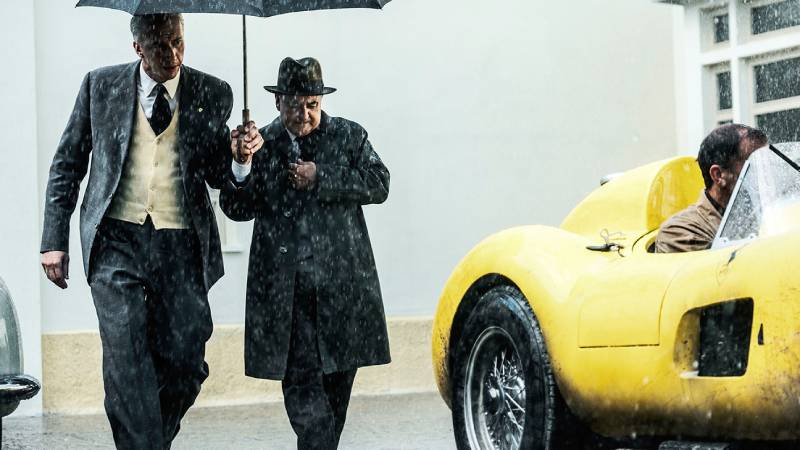




One of Shakespeare’s most famous queries, “What’s in a name?”, is not one I necessarily thought would have come to mind when watching a biopic about Enzo Ferrari. Yet Michael Mann, whose existential romanticism commingles with an aesthetic of immaculate precision, has made a career of telling stories about stoic men and the numerous factors that inform who they are. The name Ferrari carries plenty of weight within the national consciousness of Italy, though this elegiac, often sombre movie couldn’t be called a hagiography.
For Enzo (Adam Driver), his name denotes a standard of quality he struggles to maintain. In 1957, his business is in the red and banking on the success of his drivers to boost badly needed revenue. Ferrari employs a crew to compete in the Mille Miglia race against “men with a brutal determination to win.” Among Ferrari’s team is upstart Alfonso De Portago (Gabriel Leone), whom Enzo hires on the spot almost immediately after another driver (Marino Franchitti) is killed in a test drive.
“I have compassion!”, he fecklessly retorts to his wife Laura (Penélope Cruz). Partners in life as well as business, their relationship is barely functioning following the recent death of their only son, Dino. The affair Enzo carries on with Lina Lardi (Shailene Woodley) and their 10-year-old child Piero, only further roils a tempestuous situation. That Enzo and Lina’s tryst is an open secret in Modena does little to dissuade the former from preventing his wife from discovering his indiscretion and, potentially, withdrawing her critical financial support. But as Lina angrily tells the father of her child, “Who speaks for him?”
Mann’s film sings when it mulls the intergenerational baggage which impedes personal freedom. Enzo’s mother Adalgisa (a wonderfully acerbic Daniela Piperino) preserves the memory of her late husband and Enzo’s older brother, who both perished from influenza during the WW1 (“The wrong son died”, she casually shrugs). The late Troy Kennedy Martin’s screenplay acutely pinpoints the specific ways grief manifests for each member of the Ferrari family, yet it’s Laura whose silence is most deeply felt. Her eventual discovery of Lina and Piero incorporates a key object she wordlessly discovers outside their home. What that is, I’ll leave you to discover and to admire, as I did, how Mann trusts both his actors and audience to intuitively grasp its haptic and painful significance.

Cruz imbues Laura, the best female character in any of Mann’s films, with such ferocious intelligence that her absence is felt in the comparatively anodyne exchanges between Enzo and Lina. Woodley, a fine actress in her own right, never quite masters a discernible accent, a fact which hampers her major monologue. Driver himself cuts an imposing figure, yet paradoxically feels like an outside observer of his own life. This may dramatically constrict his chameleonic abilities, yet it’s a thematically apt decision for a character whose lingering thread tethering him to earth is the little control he exerts in his public persona and organisational structure.
Mann’s kinetic knack for visualising the sociological dimensions of power unsurprisingly produces some striking imagery. An early scene set in a church crosscuts between men checking their stopwatches in the pews and a Ferrari car speeding along a track. The ecclesiastical fervour of speed and excellence, Mann implies, is firmly intertwined with secular desires. Of course, he himself is captivated enough by this dynamic to give the climactic racing scenes a liquid splendour, more hypnotically zen than traditionally suspenseful. Yet history intercedes upon the precarious control men hold over their mortality, and the result (which I would recommend the squeamish look up before seeing the film) is horrific.
The impossibility of looking beyond hindsight is reinforced by the film’s stark, recurring close-ups of characters looming in the foreground with near-Wellesian import. But unlike Citizen Kane, Ferrari isn’t a riddle nested inside cinematic pyrotechnics. Instead, it’s a meditation on the weight of a legacy inundated by death. The vicarious thrill borne from the illusion of mastering mortality is thinly separated by the irrevocable collateral damage death can wreak upon innocent lives. With the 20th century’s technological advancements, that line grew thinner, and Mann’s potent awareness of its shrinkage in the 21st makes his art that much more poignant.
Ferrari showed at the 61st New York Film Festival, where this piece was written. It also showed at the 67th BFI London Film Festival (as a surprise movie), at the Best of Festivals section of the Tallinn Black Nights Film Festival, and at the 3rd Red Sea International Film Festival.
















